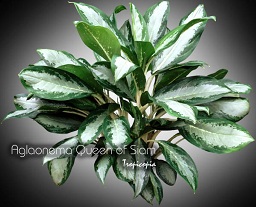Table of contents
Chinese Evergreen

Latin Name: Aglaonema ‘Queen of Siam’
Category: Aglaonema
Family: Araceae
Origin: Hybrid
Climate: Tropical
Growing Zones: 11
Care Instructions
The Chinese Evergreen (Aglaonema ‘Queen of Siam’) is a tropical plant that originates from Hybrid. This aglaonema plant belongs to the Araceae family and is well-suited for growing in USDA zones 11.
Complete Care Guide for Chinese Evergreen (Aglaonema ‘Queen of Siam’)
Watering Requirements
The Chinese Evergreen, particularly the ‘Queen of Siam’ variety, thrives with moderate watering. It is essential to allow the top inch of soil to dry out between waterings to prevent root rot, which is a common issue with this plant. During the growing season, typically spring and summer, you should water the plant more frequently, about once a week, depending on the humidity and temperature of your environment. In the fall and winter months, reduce watering to every two weeks as the plant enters a dormant phase. Always ensure that the pot has drainage holes to allow excess water to escape, and consider using room temperature water to avoid shocking the roots.
Light Conditions
Chinese Evergreens prefer bright, indirect light but can also tolerate low light conditions, making them ideal for indoor spaces. Direct sunlight can scorch the leaves, so it’s best to place them near a window with filtered light or in a well-lit room. If the plant is not receiving enough light, you may notice slower growth and less vibrant leaf coloration. Conversely, if the leaves start to yellow or develop brown tips, it may be a sign of too much direct sunlight. For optimal growth, aim for a balance of light that mimics their natural habitat, which is the understory of tropical forests.
Soil Preferences
The ideal soil for the Chinese Evergreen is a well-draining potting mix that retains some moisture without becoming waterlogged. A blend of peat moss, perlite, and pine bark works well, providing the necessary aeration and drainage. It’s also beneficial to incorporate a slow-release fertilizer during the growing season to promote healthy growth. Fertilizing every 4-6 weeks with a balanced, water-soluble fertilizer can enhance the plant’s vibrancy and overall health. Be cautious not to over-fertilize, as this can lead to salt buildup in the soil, which can harm the roots.
Pests and Diseases
Chinese Evergreens are generally resilient but can be susceptible to pests such as spider mites, aphids, and mealybugs. Regularly inspect the undersides of leaves and the stems for any signs of infestation. If you notice pests, treat them promptly with insecticidal soap or neem oil, ensuring to follow the product instructions carefully. Additionally, root rot can occur if the plant is overwatered or if the soil does not drain well. To prevent this, ensure proper watering practices and use a suitable potting mix. Fungal infections can also arise in overly humid conditions, so maintaining good air circulation around the plant is crucial.
Special Care Tips
To keep your Chinese Evergreen ‘Queen of Siam’ thriving, consider the following special care tips: First, regularly wipe the leaves with a damp cloth to remove dust, which can hinder photosynthesis and reduce the plant’s overall health. Additionally, this plant enjoys humidity, so if your home is particularly dry, especially in winter, consider using a humidifier or placing a tray of water with pebbles beneath the pot to increase moisture levels. Rotate the plant occasionally to ensure even growth and prevent it from leaning towards the light source. Lastly, be mindful of temperature fluctuations; Chinese Evergreens prefer temperatures between 65°F to 80°F (18°C to 27°C) and should be kept away from cold drafts or heat sources.








